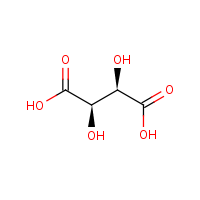L-Tartaric acid
Agent Name
L-Tartaric acid
CAS Number
87-69-4
Formula
C4-H6-O6
Major Category
Other Classes

Synonyms
Butanedioic acid, 2,3-dihydroxy- (2R,3R)-; Tartaric acid, L-(+)-; Tartaric acid, L-; (+)-(R,R)-Tartaric acid; (+)-L-Tartaric acid; (+)-Tartaric acid; (2R,3R)-(+)-Tartaric acid; (R,R)-Tartaric acid; 1,2-Dihydroxyethane-1,2-dicarboxylic acid; 2,3-Dihydroxybutanedioic acid; Acidum tartaricum; Butanedioic acid, 2,3-dihydroxy-; Cichoric acid; d-alpha,beta-Dihydroxysuccinic acid; d-Tartaric acid; Dextrotartaric acid; Kyselina 2,3-dihydroxybutandiova [Czech]; Kyselina vinna [Czech]; L-(+)-Tartaric acid; Natural tartaric acid; Succinic acid, 2,3-dihydroxy; Tartaric acid; Threaric acid; [ChemIDplus] (2R,3R)-2,3-Dihydroxybutanedioic acid; Ordinary tartaric acid; L-2,3-Dihydroxybutanedioic acid; Weinsaure (German); Weinsteinsaure (German); [Merck Index]
Category
Organic Acids
Description
Solid; [Merck Index] Colorless or translucent odorless solid; [JECFA] White odorless crystals; [Alfa Aesar MSDS]
Sources/Uses
Levo form of dextrorotatory tartaric acid; Found throughout nature and classified as a fruit acid; Used in soft drinks and foods, as an acidulant, complexing agent, pharmaceutic aid (buffering agent), in photography, tanning, ceramics, and to make tartrates; Diethyl and dibutyl ester derivatives are commercially significant for use in lacquers and in textile printing; [Merck Index] Used as an intermediate, in construction and ceramics applications, in cleaning products, cosmetics/personal care products, and metal surface treatments (including galvanic and electroplating products); [ECHA REACH Registrations] Used as a flavoring agent, anticaking agent, drying agent, firming agent, humectant, leavening agent, and pH control agent for foods; [FDA] Permitted for use as an inert ingredient in non-food pesticide products; [EPA]
Comments
A local irritant; [Merck Index] May cause serious eye injury; [ECHA REACH Registrations] Maximum total daily intake of tartrate of 0-6 mg/kg (unconditional acceptance) and 6-20 mg/kg (conditional acceptance); [JECFA] A skin and strong eye irritant; [Alfa Aesar MSDS]
Biomedical References
Exposure Assessment
MAK
2 mg/m3, inhalable fraction
Vapor Pressure
1.48E-07 mm Hg
Diseases, Processes, and Activities Linked to This Agent
Processes
Industrial Processes with risk of exposure: